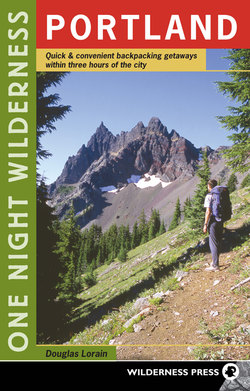Читать книгу One Night Wilderness: Portland - Douglas Lorain - Страница 21
На сайте Литреса книга снята с продажи.
8 Cispus Point
Оглавление| RATINGS | Scenery 7 Difficulty 3 Solitude 9 | |
| ROUND-TRIP DISTANCE | 5.6 miles (with side trip) | |
| ELEVATION GAIN | 1400 feet | |
| OPTIONAL MAP | Green Trails: Blue Lake | |
| USUALLY OPEN | July to October | |
| BEST TIMES | July | |
| AGENCY | Cowlitz Valley Ranger District (Gifford Pinchot National Forest) | |
| PERMIT | None |
Highlights
This short but exciting hike takes you into a small but very attractive parcel of roadless terrain not far from Packwood, Washington. Since most hikers prefer the more famous trails around the scenic wonders of nearby Mt. Rainier and the Goat Rocks, it’s not surprising that few people visit Cispus Point. Those who do are rewarded not only with solitude but with exceptional scenery, including plenty of views of those much more crowded attractions.
Getting There
Leave Interstate 5 north of Vancouver, Washington, at Exit 68 and travel 61 miles east on U.S. Highway 12 to an unsigned junction with Forest Road 20 near Milepost 127.6. Turn right (south) on this narrow and sometimes rough gravel road, staying on the main route at several minor intersections for 9.2 miles. Park at a pullout on the left about 0.2 mile past the signed trailhead for Jackpot Lake and just before the road leaves an old clear-cut.
Hiking It
The unsigned but obvious trail goes southwest along the edge of the clear-cut for 0.2 mile to a junction with the Klickitat Trail. Turn right and wander through a forest of mountain hemlocks and Alaska yellow cedars, which provide lots of welcome shade, but block most of the views. In July, wildflowers such as valerian, avalanche lily, columbine, wallflower, pink heather, bluebell, and lupine provide plenty of color, especially in places that get a bit more sun. Those breaks in the forest cover also provide views of bulky, snow-covered Mt. Adams to the south.
At 0.4 mile you begin an uphill traverse of an open rocky slope directly beneath the imposing cliffs on the east face of Cispus Point. The ascent ends at a junction in a small meadow with a shallow seasonal pond. Look for marsh marigolds and western anemones growing in the wet soils here.
The trail that goes left at this junction is the route to Cispus Point. Since this is such an easy hike, however, it is worth spending a little extra time and energy on a short side trip. So drop your pack and take the trail to the right, hiking mostly on the level through an open forest of subalpine firs and mountain hemlocks around the southwest side of massive Castle Butte. After 0.8 mile you come to a signed fork. The main Klickitat Trail goes left, but veer right, climb briefly to a saddle with a terrific view of Mt. Rainier, and then descend a little before turning north for a fun and scenic walk beneath the towering cliffs of Twin Sisters. This is the logical turnaround point for the side trip.
Back at the meadow junction, go south on the dead-end spur trail to Cispus Point, which climbs through forest then over open slopes before passing above a pair of small ponds with a couple of good and wildly scenic campsites. These camps are a bit exposed and the ponds are too shallow for either swimming or fishing, but they feature terrific views and plenty of solitude. The sunrises here can be spectacular. The trail continues past the pond, ascending to a ridgetop where it switchbacks to the right, and then climbs to the cliff-edged top of Cispus Point. The views here are outstanding and include all of the big volcanic peaks of southern Washington—Rainier, Adams, St. Helens, and the eroded old volcano of the Goat Rocks. You can also look south to Oregon’s Mt. Hood and see countless smaller rocky ridges and summits closer at hand. Sadly, several clear-cuts are also visible, but even they can’t spoil a view that is this good.
Mt. Rainier from Cispus Point
